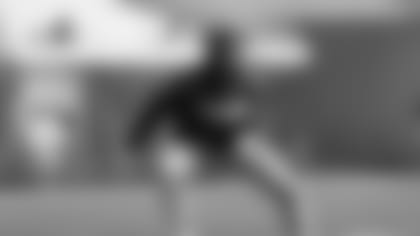Back in the early 1980s when I was a wee lad, I learned a little bit about these things people were calling "personal computers." Yeah, I'm that old. Either way, I learned a little bit about computer programming, elementary though it was, but I did. Thankfully, most of the programming I learned was encapsulated with "if/then" statements.
If the sky was blue, then it was a clear day.
If it was Wednesday, then it was enchilada day at school.
Simple stuff and who doesn't like enchilada day, right? It's amazing how much football reminds me of an enchilada dinner. Hunger games aside, it's no surprise that football is nothing but a series of "if/then" statements.
If the linebacker does this, then throw that. If the quarterback checks to this play, then change your play to that.
One of my favorite "if/then" connectors is the backshoulder fade. I don't know it's exact origin but it's become one of the most deadly "then" answers to an "if" question.
Thing is, there wasn't an answer for long while, especially when I played in college. During the late 1980s and early 1990s, the passing game was exploding in complexity. The Run and Shoot. The Fun and Gun. The West Coast Offense. Each pass-heavy scheme was instrumental in the growth of the passing game in college and the NFL. Inside the red zone, though, teams aimed to take advantage of big receivers and one-on-one coverage, so the fade route became a weapon for many teams.
When running a fade route, a receiver "faded" to the back corner of the end zone as the quarterback lofted a pass high to the back pylon. It was imperative that the receiver beat the defensive back to the spot and snatch the pass behind the defensive back.
As a former defensive back, I can tell you that the fade route was one of most difficult things to cover and the only way a DB had a chance was to anticipate the fade and beat the receiver to the spot. But, as defensive backs defended more and more fade routes, their technique improved and the fade route became exceedingly difficult to complete.
So, offensive minds often asked "if the defender is close enough to beat the receiver to the fade spot, then…well, what do we do?"
Someone, some offensive genius stumbled on the backshoulder throw. The first time I saw a team use it, I thought it was by luck. Then, I saw it again. And again. And again. I realized that throwing the ball at the DBs backshoulder, short of the receiver, allowed the receiver to work back to the ball because he saw it and the defender didn't. Genius!
So, if the defensive back is chasing and losing the race, then throw the fade. If he's lockstep with the receiver, then throw the backshoulder fade.
Simple, right?
Here's a look at how the Texans used the backshoulder fade against the Tennesse Titans. Backed up near their own goal line, on 3rd and eight, the Texans had 11 personnel in the game and aligned in a 2x2 set with DeAndre Hopkins to the right side of the formation.
On the snap, the Titans brought pressure on QB Ryan Fitzpatrick and the secondary was playing "blitz 1" - man coverage with a safety playing free in the middle of the field. The Titans in the circles locked on Texans receivers and Titan safety Michael Griffin (arc) covered Arian Foster out of the backfield.
In the rectangle, Titans CB Blidi Wreh-Wilson locked on Hopkins.
That's the matchup Fitzpatrick targeted immediately, post snap.
Wreh-Wilson had excellent coverage and was step for step with Hopkins as the Texan receiver sprinted downfield. Fitzpatrick made it quite clear that he wanted to throw to Hopkins. But, the initial coverage was excellent. So, what did Fitzpatrick do?
That's right. He threw the backshoulder fade, anticipating that Hopkins would realize the same thing. As Hopkins looked back for the ball, he saw that Fitzpatrick threw short of Wreh-Wilson, directly at his backshoulder. Hopkins adjusted because he can see the throw, while Wilson, with his back to Hopkins, couldn't.
Hopkins threw on the brakes, worked his way in front of Wreh-Wilson and finally got separation from the Titans CB.
Result? Easy catch for Hopkins and a key first down.
Had Hopkins beaten Wreh-Wilson off the ball, Fitzpatrick would've lead him on the fade route. But, he didn't so Fitzpatrick and Hopkins used Wreh-Wilson's great coverage against him with the backshoulder fade. If. Then. I get it.
Finally, an "if/then" statement I could truly understand.














